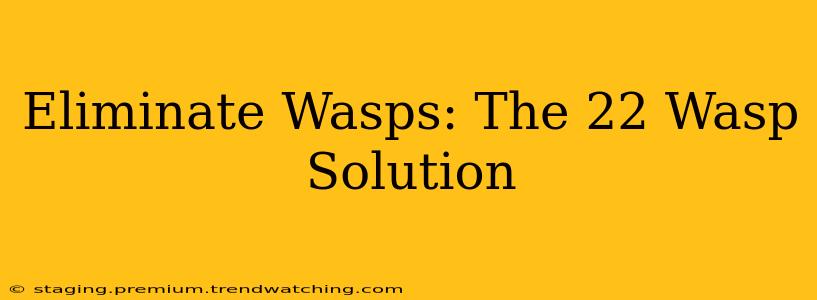Wasps. The mere mention of the word can send shivers down the spine. These buzzing insects, while playing a vital role in the ecosystem, can be a serious nuisance, and even a danger, when they build nests near human activity. If you're dealing with a wasp infestation, you're likely searching for effective and safe solutions. This comprehensive guide explores 22 ways to eliminate wasps, from preventative measures to effective removal techniques. We'll cover everything you need to know to reclaim your space from these stinging intruders.
Understanding Wasps: A Necessary First Step
Before diving into solutions, it's crucial to understand the type of wasp you're dealing with. Different species exhibit varying behaviors and require different approaches to removal. Common types include yellow jackets, paper wasps, hornets, and mud daubers. Identifying the species can help you choose the most effective control method.
22 Wasp Control Solutions: A Comprehensive Guide
This section details various methods for wasp control, categorized for clarity:
I. Preventative Measures:
- Seal Cracks and Gaps: Wasps often enter homes through small openings. Regularly inspect your home's exterior and seal any cracks or gaps in walls, windows, and foundations.
- Remove Food Sources: Keep food and drinks covered, especially outdoors. Clean up spills immediately and store garbage in tightly sealed containers.
- Maintain Cleanliness: Regularly clean patios, decks, and outdoor areas to eliminate food scraps and attractants.
- Secure Trash Cans: Use lids that securely fasten to prevent wasps from accessing garbage.
- Eliminate Standing Water: Wasps, like other insects, are attracted to water sources. Eliminate standing water in gutters, birdbaths, and other areas.
II. Non-Lethal Removal Methods:
- Relocation (For Small Nests): If you discover a small nest early in its development, you might be able to carefully relocate it. This requires protective gear and should only be attempted by those comfortable with handling wasps.
- Natural Repellents: Certain scents, such as peppermint oil, citronella, and cloves, can deter wasps. Diffuse these scents or place plants with these aromas near potential entry points.
- Wasp Traps: Commercial and DIY wasp traps can lure wasps away from your home. Choose traps that use bait attractive to the specific wasp species you're dealing with.
III. Lethal Removal Methods (Use with Caution):
- Insecticidal Sprays: Commercial wasp sprays are effective, but use them cautiously and follow all instructions on the label. Always wear protective clothing.
- Dust Insecticides: These are effective for treating nests, particularly those in hard-to-reach areas. Apply the dust directly into the nest entrance.
- Wasp Killer Foams: These foams reach into crevices where sprays can't, making them suitable for treating nests in wall voids.
- Professional Extermination: For large nests or infestations, it's best to call a professional pest control service. They have the expertise and equipment to safely and effectively remove wasps.
IV. Addressing Specific Situations:
- Wasps in the Walls: This requires a professional approach as treatment will need to be thorough to prevent recurrence.
- Wasps in the Attic: Similarly, accessing and treating nests in attics should be left to professionals to ensure safety and effective removal.
- Wasps Near Children's Play Areas: Immediate removal is crucial. Prioritize safety and consider professional assistance.
- Wasps Near a Swimming Pool: Removing the nest swiftly reduces the risk of stings.
- Wasp Nest Removal at Night: Wasps are less active at night, making it a safer time for removal but still requires caution.
- Removing a Wasp Nest During the Day: This is riskier but sometimes unavoidable. Always wear protective clothing and use appropriate removal techniques.
V. Post-Removal Steps:
- Monitor the Area: After removing a wasp nest, monitor the area for any remaining wasps or signs of new activity.
- Dispose of the Nest Properly: Remove the nest carefully and seal it in a plastic bag before discarding it in the trash.
- Repair Entry Points: Once the nest is removed, repair any holes or gaps to prevent future infestations.
- Preventative Maintenance: Continue to practice preventative measures to minimize the risk of future wasp infestations.
Frequently Asked Questions (FAQ)
What attracts wasps to my property? Sweet-smelling substances, uncovered food and drinks, garbage, and standing water are all significant attractants for wasps.
Are wasp stings dangerous? Most wasp stings are painful but not life-threatening, unless you have an allergy. Allergic reactions can be severe and require immediate medical attention.
What should I do if I get stung by a wasp? Remove the stinger (if present), clean the area with soap and water, apply a cold compress to reduce swelling, and monitor for allergic reactions.
This comprehensive guide provides a range of solutions for dealing with wasps. Remember to prioritize safety and consider professional help when dealing with large nests or if you're uncomfortable handling wasps yourself. By combining preventative measures with appropriate removal techniques, you can effectively eliminate wasps and regain control of your outdoor space.

